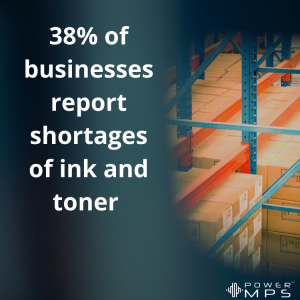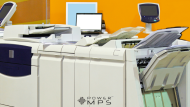It’s becoming clear that the COVID-19 response has thrown the global supply chain for a loop. Mass closures had manufacturing plants either working with severe restrictions or completely shut down. Most industries had a backlog of stock to fill the anticipated lower order rates for the balance of the pandemic.
But the fast move to work-from-home combined with generous financial support for those temporarily out of work meant many businesses saw no slow-down in orders. Instead, many industries saw an increase in orders. The demand quickly ate through stockpiles and led to significant shortages.
Continued COVID scares and constantly changing regulations keep manufacturers from meeting ongoing needs. In addition, completing orders has become a challenge because of ongoing labor shortages, worldwide port closures, and an epidemic of shipping delays. Business printing is just one of the many standard business processes feeling these effects.
Printers Are Hard To Find
Early in the pandemic response, there was a rush on consumer printers, and personal printer sales grew eleven percent. But the small machines people can purchase at Walmart are not the only things that are difficult to buy. Business printers and their associated parts are also surprisingly troublesome to the source. One of the main troubles leading to this shocking lack of supply is the shortage of semiconductors.
Semiconductor chips are used in a wide range of electronics. They are essential parts of nearly everything we use, including smartphones, cars, personal computers, and printers. Like most manufacturers, the facilities producing these necessary chips face closures and extensive shipping delays. But they are also one of the hardest hit by the sudden and unexpected increase in demand. As a result, the modest stockpiles of chips were quickly eaten through in early 2020, and the industry has scrambled to meet demand ever since.
Semiconductor manufacturers including Intel, Taiwan Semiconductor Manufacturing Company, and Samsung are moving to spend hundreds of billions on increasing capacity. But disruptions continue to affect consumer and office printing manufacturers, including Canon, Epson, Brother, and HP. And, despite regular attempts to generate an appropriate supply of printing devices, many remain sitting on loading docks or stuck in shipping.
Printing Hardware Is Not The Only Supply Affected
Like the semiconductor market, the paper industry settled in for shutdowns in March of 2020 with a comfortable backlog of supply. No one anticipated the sudden uptick in home construction products and a massive boost to the real estate market. Rather than seeing a downturn, sales of new homes went through the roof. And paper demand increased to the tune of $38B. And, as with semiconductors, lumber availability hit an all-time low.
Now mills are scrambling to ramp up production to pre-COVID levels. In the meantime, the domestic print industry faces a significant shortage of paper supplies. As a result, prices on reams are higher than ever, with increases in 2021 climbing as high as 20%.
Ink And Toner Are No Exception
 Anticipating lower demand for ink and toner due to global office closures, many ink and toner manufacturers took the opportunity to convert machinery to produce cleaning supplies and hand sanitizer. Imagine their surprise to discover demand for printing took less of a hit than anticipated. Now well over a quarter (38%) of small businesses report supply shortages with ink and toner in high demand.
Anticipating lower demand for ink and toner due to global office closures, many ink and toner manufacturers took the opportunity to convert machinery to produce cleaning supplies and hand sanitizer. Imagine their surprise to discover demand for printing took less of a hit than anticipated. Now well over a quarter (38%) of small businesses report supply shortages with ink and toner in high demand.
Perhaps most surprising is how the semiconductor shortage has taken a toll on the availability of ink and toner cartridges. Printer manufacturers have been using this technology in their printing components for decades to monitor quality, performance, and ink levels. However, in recent months, the semiconductor supply problem has become enough of an issue that printer manufacturer Canon has announced it will temporarily produce without the chips. It is also pushing software updates to allow hardware to operate with the updated format.
Printing Partners Help Beat The Shortage
Offices worldwide are faced with a potential issue when it comes to meeting print demands for their business. Whether it is access to appropriate hardware or ensuring ongoing consumables availability, IT and administrators are facing rising costs and limited supply. Fortunately, there are ways to help buffer against these problems by partnering with a reputable printer service partner. When it comes to high-end office printing hardware or the ability to source supplies consistently, printing experts keep tabs on availability and pricing to minimize the effects their partners feel from the ongoing global shortages companies are facing.







